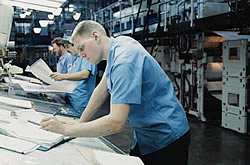Designing with digital mock-up process simulation
From its design to its manufacture, a product is subjected to numerous verification procedures. Current methodologies consist of the creation of physical product models (prototype mock-ups) on which designers, manufacturers and management perform testing procedures in order to evaluate the product, construct design changes and modify where necessary. Normally, this is extremely time consuming and may result in product delays and redesign, hence greater product costs. This project focused on developing a simpler, faster and more cost-effective technology that offers the designer the means to work within a digital mock-up environment. Using such a system product designers and subassemblies have the capability to model and simulate assembly, disassembly, service and maintenance processes all during the designing phase. The technology consists of informatics tools based on a well-established conceptual structure that consists of the Process Library, the Resource Library, the Knowledge Module, Simulation Features, and the Integrated Framework. Process knowledge that has already been gained during the very early conceptual stage of the design process and throughout downstream product development is embedded. Moreover, old processes may be reused, along with past and present reference material and documentation. Following the lifecycle of a product and its development, equipped with standardised processes, allows the product and process designers to gain easy access to the relevant data containing continuously updated information. The introduction of this technology leads to a reduction of development time (at least 10%) and a considerable enhancement of product quality, since scrap and defects will be substantially minimised. Additionally, the reduction of physical mock-up's and reducing design delays will essentially improve manufacturing costs. The new digital mock-up technology allows companies to work in a concurrent engineering environment independent of their size and product configuration, to study the optimal production site configuration regarding the lay out and distribution of resources. Furthermore, its adoption ensures increased flexibility, competitiveness and improvements though a much shorter “time to market” of products. Apart from the automotive and aerospace industry, it is anticipated that this new technology will have a great impact on other industrial manufacturing sectors, such as general manufacturing and machinery, consumer products and electromechanical industries, to name just a few.



